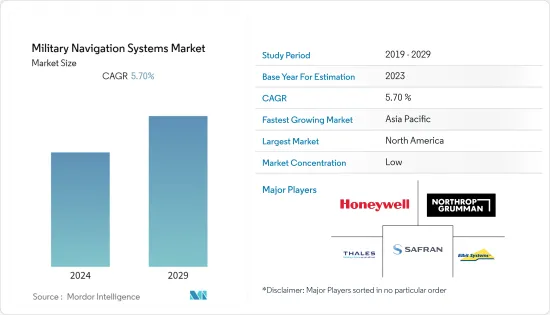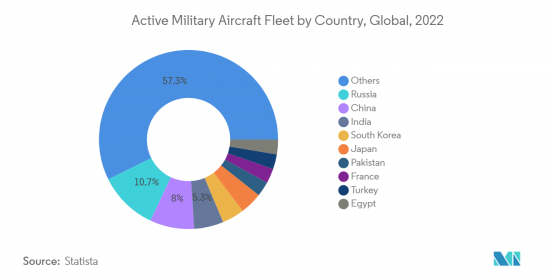PUBLISHER: Mordor Intelligence | PRODUCT CODE: 1405357

PUBLISHER: Mordor Intelligence | PRODUCT CODE: 1405357
Military Navigation Systems - Market Share Analysis, Industry Trends & Statistics, Growth Forecasts 2024 - 2029

The Military Navigation Systems Market is valued at USD 9.25 billion in 2024 and is expected to reach USD 12.21 billion by 2029, growing at a CAGR of 5.7% during the forecast period (2024-2029).
The increasing military spending of the countries is supporting their governments' respective procurement plans for a wide range of products for military operations from intelligence, surveillance, and reconnaissance to combat and battlefield. Such procurement plans for manned and unmanned systems, along with precision-guided munitions, are anticipated to drive the demand for the navigation systems market in the military sector in the coming years.
The modernization plans of the armed forces to upgrade their military equipment are anticipated to further propel the sales of the navigation systems during the forecast period. The development of new navigation systems that can provide accurate positioning (even in case of GNSS jamming or spoofing), with compact size, lightweight, and low power consumption, is anticipated to help the companies in generating and bolstering the growth of the market during the forecast period.
The introduction of military navigation helped to improve the selection of weapons, delivery of supplies on the battlefield, commandership, and control, as well as guidance characteristics for an unmanned system. High-performance navigation systems for a large number of applications in the aviation sector require very specific guidance and accuracy and are increasingly in demand. These systems, which are precisely placed for a wide range of applications, are employed in many types of warfare, including air and sea navigation.
Military Navigation Systems Market Trends
The Air Segment is Projected to Retain Market Share Dominance
The armed forces around the world are significantly investing in the procurement of new aircraft and UAVs. Most of the aircraft use GNSS (GPS) and TACAN positioning and navigation systems. The majority of the revenue of the segment is through the modernization of the aging fleet of aircraft with new and accurate positions and navigation systems. For instance, in June 2023, Airbus Helicopters awarded a contract to Safran Electronics & Defense for the SkyNaute navigation system for the aircraft to be deployed by French and Spanish armed forces. SkyNaute is an ultra-compact hybrid inertial navigation system based on Safran's patented Crystal HRG (hemispherical resonator gyro) technology. SkyNaute offers an extremely lightweight and compact design, combining high integrity and precision. The SkyNaute navigation system delivers outstanding reliability, even in environments where satellite navigation signals are absent or jammed. Similar initiatives from various armed forces are anticipated to propel the growth of the segment during the forecast period.
Furthermore, the development of new navigational aids for the aircraft is anticipated to open new market opportunities for the companies. Similarly, in May 2023, the US Air Force awarded a USD 750 million contract to Lockheed Martin Corporation to build JASSM-ER GPS-guided missiles with infrared seeker technology for launch from B-2 bombers. The JASSM-ER is a 2,250-pound cruise missile that uses precision routing and guidance in adverse weather, day or night. It uses an infrared seeker in addition to the anti-jam GPS to find a specific aim point on the target.

Asia-Pacific is Projected to Generate the Highest Demand During the Forecast Period
The steady growth of military spending in countries such as China, India, and South Korea, among others, is majorly driving the procurement and modernization plans of military equipment. China includes regional tensions with Japan, South Korea, and Taiwan. These conflicts led China and its neighboring countries to invest in military modernization programs. The majority of the Asia-Pacific countries are modernizing their military platforms. The countries are procuring new aircraft to increase their air strength and strengthen their sea ISR capabilities by procuring new ships. Currently, along with manned capabilities, the countries are also involved in developing and upgrading their unmanned capabilities. For instance, in September 2022, Russia and China signed contracts for the deployment of Russia's GLONASS stations in China and China's BeiDou system stations in Russia. Russia's GLONASS stations will be in Changchun, Urumqi, and Shanghai, and the Chinese ones will be in Obninsk, Irkutsk, and Petropavlovsk-Kamchatsky. BeiDou and GLONASS, which are alternatives to the United States' Global Positioning System (GPS), will improve the performance of their systems. It provides precision, navigation, and timing (PNT) services for both military and civilian purposes. Similarly, in July 2023, Elbit Systems won a 5-year USD 114 million contract to supply two long-range patrol aircraft (LRPA) to an unnamed Asian-Pacific nation. The LRPA aircraft will be integrated with a comprehensive mission suite, including a mission management system, electro-optics, radar, signals intelligence (SIGINT), and communication.
Military Navigation Systems Industry Overview
The market for military navigation systems is fragmented, with many players in the market who provide various navigation components to different military platforms for diverse military operations. The prominent players in the military navigation systems market are Northrop Grumman Corporation, Safran, THALES, Honeywell International Inc., and Elbit Systems Ltd. To increase their revenue share in the market, the players are developing new products and expanding their product portfolio into various platforms. For instance, Northrop Grumman Corporation provides its navigation and positioning systems to a variety of platforms, such as fixed and rotary-winged aircraft, ships, underwater vehicles, land vehicles, satellites, and missiles. With such a huge portfolio, the company is anticipated to cater to the requirements of various platform manufacturers.
Additionally, the development of new and advanced navigation and positioning systems, with low power consumption, small size, and lightweight, is anticipated to support the growth of the companies. For instance, in January 2023, SandboxAQ, an enterprise SaaS company, was awarded a Direct-to-Phase-II Small Business Innovation Research (SBIR) contract by the US Air Force to research quantum navigation technologies. As per the contract, a prototype of the company AQ quantum-powered sensors will be optimized in close coordination with the US Air Force. Similarly, in July 2023, Australia's Department of Defence awarded a multi-million contract to Q-CTRL (Australia) to develop quantum sensors for military platforms. The program aims to build quantum-enhanced positioning and navigation capability built on Q-CTRL's software-ruggedized quantum sensing technology. It can detect minute changes in acceleration and gravitational field and also remove noise from the signal.
Additional Benefits:
- The market estimate (ME) sheet in Excel format
- 3 months of analyst support
TABLE OF CONTENTS
1 INTRODUCTION
- 1.1 Study Assumptions
- 1.2 Scope of the Study
2 RESEARCH METHODOLOGY
3 EXECUTIVE SUMMARY
4 MARKET DYNAMICS
- 4.1 Market Overview
- 4.2 Market Drivers
- 4.3 Market Restraints
- 4.4 Porter's Five Forces Analysis
- 4.4.1 Bargaining Power of Suppliers
- 4.4.2 Bargaining Power of Buyers/Consumers
- 4.4.3 Threat of New Entrants
- 4.4.4 Threat of Substitute Products
- 4.4.5 Intensity of Competitive Rivalry
5 MARKET SEGMENTATION
- 5.1 Platform
- 5.1.1 Air
- 5.1.2 Land
- 5.1.3 Sea
- 5.1.4 Space
- 5.2 Application
- 5.2.1 Command & Control (C2)
- 5.2.2 Intelligence, Surveillance & Reconnaissance (ISR)
- 5.2.3 Targeting & Guidance
- 5.2.4 Search & Rescue
- 5.3 Geography
- 5.3.1 North America
- 5.3.1.1 United States
- 5.3.1.2 Canada
- 5.3.2 Europe
- 5.3.2.1 United Kingdom
- 5.3.2.2 France
- 5.3.2.3 Germany
- 5.3.2.4 Italy
- 5.3.2.5 Russia
- 5.3.2.6 Rest of Europe
- 5.3.3 Asia-Pacific
- 5.3.3.1 China
- 5.3.3.2 India
- 5.3.3.3 Japan
- 5.3.3.4 South Korea
- 5.3.3.5 Rest of Asia-Pacific
- 5.3.4 Latin America
- 5.3.4.1 Mexico
- 5.3.4.2 Brazil
- 5.3.4.3 Rest of Latin America
- 5.3.5 Middle East and Africa
- 5.3.5.1 Saudi Arabia
- 5.3.5.2 United Arab Emirates
- 5.3.5.3 Qatar
- 5.3.5.4 Egypt
- 5.3.5.5 South Africa
- 5.3.5.6 Rest of Middle East and Africa
- 5.3.1 North America
6 COMPETITIVE LANDSCAPE
- 6.1 Vendor Market Share
- 6.2 Company Profiles
- 6.2.1 Northrop Grumman Corporation
- 6.2.2 Safran
- 6.2.3 Elbit Systems Ltd.
- 6.2.4 Honeywell International Inc.
- 6.2.5 THALES
- 6.2.6 Collins Aerospace (RTX Corporation)
- 6.2.7 KVH Industries, Inc.
- 6.2.8 CMC Electronics Inc.
- 6.2.9 General Electric Company
- 6.2.10 Israel Aerospace Industries Limited
- 6.2.11 Anschotz GmbH
- 6.2.12 Moog Inc.
- 6.2.13 Lockheed Martin Corporation
7 MARKET OPPORTUNITIES AND FUTURE TRENDS




